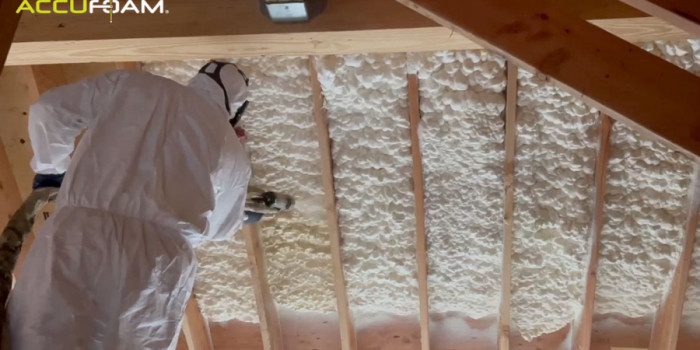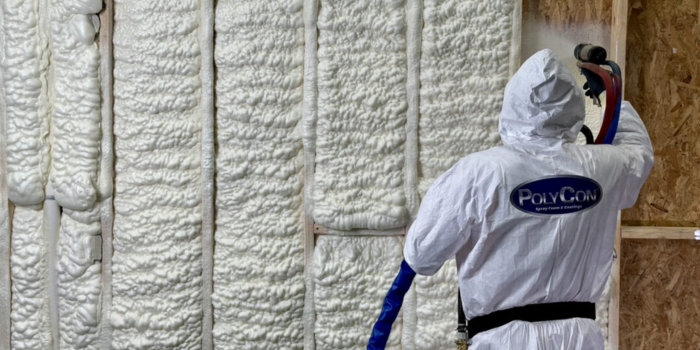Mastering Spray Foam Insulation in Hot Summer Weather


SPRAY FOAM MAGAZINE – As temperatures soar during the summer months, spray foam insulation contractors face unique challenges that can impact the quality and effectiveness of their work. However, with the right knowledge and techniques, it’s possible to achieve excellent results even in hot conditions. This article will explore best practices and pro tips for installing spray foam insulation when the mercury rises, focusing on safety precautions, material storage and handling, equipment adjustments, application techniques, timing and scheduling, substrate considerations, moisture management, and quality control. By understanding and implementing these strategies, contractors can ensure successful installations and satisfied clients.
Safety Precautions
Working with spray foam in hot conditions requires additional safety measures. Use cooling vests or portable fans to prevent heat stress while wearing protective equipment. Schedule frequent breaks in cooled areas and ensure all team members stay well-hydrated throughout the day. Monitor your crew for signs of heat exhaustion or heat stroke, such as dizziness, headache, nausea, or confusion, and take immediate action if any of these symptoms appear. Ensure that your team is properly trained in heat safety protocols and has access to first aid supplies and emergency communication devices in case of a heat-related incident.
Material Storage and Handling
Proper material storage and handling are critical for successful spray foam application in hot weather. Store spray foam components according to manufacturer’s guidelines, ideally in a cool, shaded area or a temperature-controlled environment, and consider using insulated boxes or coolers for transportation to the job site. Monitor the temperature of the components throughout the day, ensuring they remain between the manufacturer-recommended temperature range for optimal performance. Avoid exposing materials to direct sunlight or excessive heat, as this can cause chemical degradation and affect the final product quality. Regularly rotate your stock to ensure that older materials are used first, minimizing the risk of spoilage due to prolonged exposure to high temperatures.
Equipment Adjustments
Hot weather can affect equipment performance requiring adjustments. Increase heater temperature settings to compensate for cooler material temperatures, maintaining the proper chemical reaction and foam quality. Regularly check and clean equipment filters and screens, as heat can cause materials to thicken and potentially clog components. Consider using larger diameter hoses or shorter hose lengths to minimize pressure drop and maintain consistent material flow. Ensure that your equipment is well-maintained and properly calibrated to withstand the demands of hot weather operation and have backup parts on hand to minimize downtime in case of unexpected breakdowns.
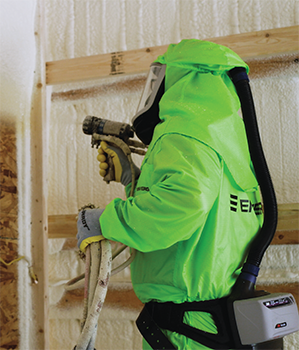
Apply thinner passes of foam to allow for better heat dissipation and proper curing, reducing the risk of scorching or improper chemical reactions.
Application Techniques
Adapting application techniques is essential in hot conditions. Apply thinner passes of foam to allow for better heat dissipation and proper curing, reducing the risk of scorching or improper chemical reactions. Increase the distance between the spray gun and the substrate, giving the foam more time to react in the air before hitting the surface, improving adhesion and reducing the risk of trapped heat. Be mindful of wind conditions, as strong winds can affect the spray pattern and lead to uneven coverage or overspray. When working in confined spaces or areas with limited ventilation, take extra precautions to ensure proper air circulation and temperature control, as heat build-up can be more pronounced in these environments.
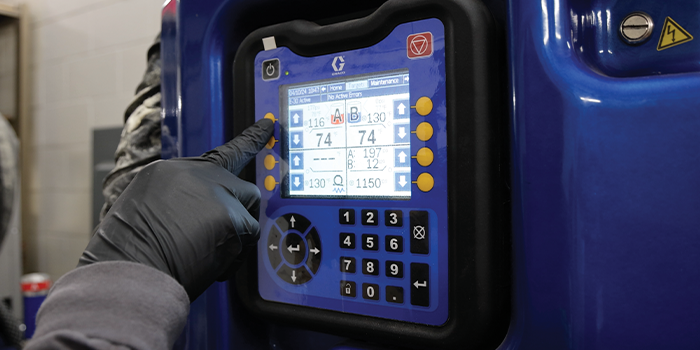
Increase heater temperature settings to compensate for cooler material temperatures, maintaining the proper chemical reaction and foam quality.
Timing and Scheduling
Strategic timing can significantly impact hot weather applications. Start the workday earlier to take advantage of cooler morning temperatures and schedule jobs to work in shaded areas during the hottest parts of the day. Allow for longer cooling periods between passes to prevent heat build-up that could affect foam quality or cause substrate damage. Be prepared to adjust your schedule as needed based on weather forecasts and actual conditions on the job site. If possible, consider postponing work on extremely hot days or breaking up larger projects into smaller, more manageable sections to minimize the impact of high temperatures on the overall installation quality.
Substrate Considerations
Hot weather can significantly impact substrate temperatures, affecting foam adhesion and performance. Use an infrared thermometer to check surface temperatures before spraying, avoiding application to surfaces above 120°F (49°C). If possible, cool down hot substrates before application using fans, water mist, or temporary shading. Pay special attention to metal substrates, as they can heat up quickly and retain heat for longer periods, potentially affecting foam adhesion and curing. In some cases, it may be necessary to apply a primer or adhesion promoter to improve bonding and minimize the risk of delamination due to thermal stress.
Moisture Management
High humidity often accompanies hot weather, which can affect foam quality. Use a moisture meter to check substrate moisture content before spraying, ensuring it remains below the manufacturer-recommended 19% for wood substrates. In high humidity conditions, consider using closed-cell foam instead of open-cell, as it’s less susceptible to moisture-related issues. Be aware that high humidity can also increase the risk of condensation on cold surfaces, such as air-conditioned walls or metal ducts, which can lead to moisture-related problems if not addressed properly. Consider using dehumidifiers or fans to control humidity levels and promote faster drying times.
Quality Control
Maintaining quality in challenging conditions requires vigilance. Regularly check the density, adhesion, and cell structure of the applied foam, as hot weather can affect these properties. Keep detailed records of environmental conditions, equipment settings, and application techniques for each job, as this information can be invaluable for troubleshooting and improving future hot weather applications. Consider using infrared cameras or core sampling to assess the quality and consistency of the installed foam and adjust as needed to ensure optimal performance. By prioritizing quality control and continuous improvement, contractors can build a reputation for delivering high-quality installations even in the most challenging conditions.
Installing spray foam insulation in hot summer weather presents unique challenges, but with careful planning and execution, contractors can achieve excellent results.
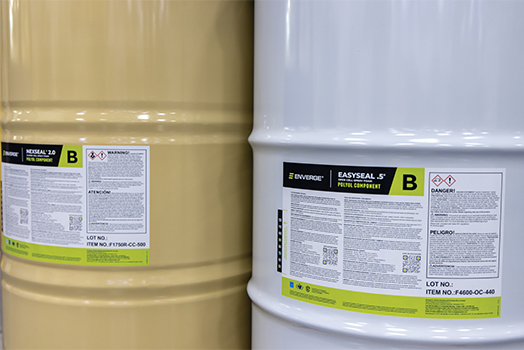
Store spray foam components according to manufacturer’s guidelines, ideally in a cool, shaded area or a temperature- controlled environment, and consider using insulated boxes or coolers for transportation to the job site.
By focusing on material handling, equipment adjustments, application techniques, and safety precautions, contractors can ensure high-quality spray foam installation even when temperatures soar. Adaptability and attention to detail are key to success in these demanding conditions. By following these best practices and pro tips, spray foam insulation contractors can confidently tackle projects during the hottest months of the year, delivering energy-efficient, comfortable, and durable solutions to their clients. With the right knowledge, tools, and strategies, hot weather installations can become a profitable and rewarding part of any spray foam contractor’s business.
Spray Foam Magazine does not take editorial positions on particular issues; individual contributions to the magazine express the opinions of discrete authors unless explicitly labeled or otherwise stated. The inclusion of a particular piece in the magazine does not mean that individual staff members or editors concur with the editorial positions represented therein.
For use by SprayFoamMagazine.com & Spray Foam Magazine
Disqus website name not provided.






